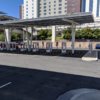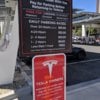No need to send messages to developers. You can edit the location yourself as a PlugShare user.
Welcome to Tesla Motors Club
Discuss Tesla's Model S, Model 3, Model X, Model Y, Cybertruck, Roadster and More.
Register
Install the app
How to install the app on iOS
You can install our site as a web app on your iOS device by utilizing the Add to Home Screen feature in Safari. Please see this thread for more details on this.
Note: This feature may not be available in some browsers.
-
Want to remove ads? Register an account and login to see fewer ads, and become a Supporting Member to remove almost all ads.
You are using an out of date browser. It may not display this or other websites correctly.
You should upgrade or use an alternative browser.
You should upgrade or use an alternative browser.
Supercharger - Las Vegas, NV (High Roller at LINQ)
- Thread starter DDotJ
- Start date
-
- Tags
- nevada supercharger Tesla Inc.
darth_vad3r
Well-Known Sith
We really need someone to accurately count them and send a message to the developers.
There are 15 destination chargers. You can see them from the videos, and tell where they are from the satellite view visible in PlugShare. 11 spots on the west side and 1 top left are open access, and 3 along the top (north) are for the disabled permit parking spots. There appear to be 1 'normal' and 2 'disabled' spots that have no charger associated with them (overflow? or room for someone to move out of a charging spot to let someone else charge before they are done with their 'parking' ?) Hmm, maybe for valet to shuffle cars?
No need to send messages to developers. You can edit the location yourself as a PlugShare user.
Right, or add a new location, which is what I just did, just for you @bwilson4web !
PlugShare - Las Vegas LINQ High Roller Tesla Destination Chargers
Last edited:
WHY?!? This is not the PlugShare standard. They all belong in one pin location, just like all the other multi-standard stations! The app is smart enough to do the filtering if selected.There are 15 destination chargers. You can see them from the videos, and tell where they are from the satellite view visible in PlugShare. 11 spots on the west side and 1 top left are open access, and 3 along the top (north) are for the disabled permit parking spots. There appear to be 1 'normal' and 2 'disabled' spots that have no charger associated with them (overflow? or room for someone to move out of a charging spot to let someone else charge before they are done with their 'parking' ?) Hmm, maybe for valet to shuffle cars?
Right, or add a new location, which is what I just did, just for you @bwilson4web !
PlugShare - Las Vegas LINQ High Roller Tesla Destination Chargers
Right. It should all be one location.WHY?!? This is not the PlugShare standard. They all belong in one pin location, just like all the other multi-standard stations! The app is smart enough to do the filtering if selected.
darth_vad3r
Well-Known Sith
WHY?!? This is not the PlugShare standard. They all belong in one pin location, just like all the other multi-standard stations! The app is smart enough to do the filtering if selected.
I did it for Bob guys ... I did it for Bob.
Right. It should all be one location.
Well anyways, the location was locked, you couldn't edit it. It's Plug*SHARE* ... I shared. It's like a wiki. Go fix it if you like
In the mean time someone using the app can now see that there are 15 destination chargers and where they are. Before a few minutes ago they didn't exist in PlugShare.
Can someone point me to a combo Supercharger/Destination charger location in PlugShare so I can see how it looks?
ps. I put the pin closer to where the Destination chargers are. The existing pin was right where the Superchargers are. It's two separate areas of the same parking lot.
darth_vad3r
Well-Known Sith
All these people complaining and reporting to developers ... it's plugshare... fix it yourself!
I just added 15 chargers to the supercharger one and updated the description and reported the other one as "inaccurate".
Why didn't the first 5 people to complain just fix it?
I just added 15 chargers to the supercharger one and updated the description and reported the other one as "inaccurate".
Why didn't the first 5 people to complain just fix it?
I fix enough crap on there and knew you’d man-up!Why didn't the first 5 people to complain just fix it?
misticjeff
Member
bwilson4web
hit the spot
Interesting, there are now two pins so PlugShare filtering for the destination chargers work:

Bob Wilson

Bob Wilson
darth_vad3r
Well-Known Sith
Interesting, there are now two pins so PlugShare filtering for the destination chargers work
LOL. Is Bob ignoring me now? After all I’ve done for him?
Chuq
Active Member
Regarding Plugshare, superchargers are treated a bit differently from other types of plugs. Because the feed is synchronised direct from Tesla the destination chargers are usually not part of the same "pin".
An example of this in another location is here - both pins are on the same site

I don't know if the destination charger data for the Linq SC location will be overwritten via a regular synchronisation from Tesla or not.. I guess we wait and see.
Also, some people have a habit of adding superchargers manually, and because they don't see a plug for "Supercharger" they add them as "Tesla destination charger" plugs. This makes the "filter by destination charger" option slightly less trustworthy, especially for newer sites.
An example of this in another location is here - both pins are on the same site
I don't know if the destination charger data for the Linq SC location will be overwritten via a regular synchronisation from Tesla or not.. I guess we wait and see.
Also, some people have a habit of adding superchargers manually, and because they don't see a plug for "Supercharger" they add them as "Tesla destination charger" plugs. This makes the "filter by destination charger" option slightly less trustworthy, especially for newer sites.
ai4px
Wes
I just thought of something to do with Tesla batteries at this location.... you know how our batteries will preheat (if needed) as you get close to a super charger? I have to wonder if the batteries at this site also know of your arrival and start drawing a little more juice from the grid to help average out the peaks? These batteries could get a head start on demand even before you arrive.
These batteries could get a head start on demand even before you arrive.
Interesting concept. Intelligent routing lets the supercharger station know in advance who is navigating to the Supercharger location. Software in turn figures out how much to draw from the grid in addition to solar to hopefully bring the batteries up a bit in order to smooth out a peak when those cars plug in, further reducing demand charges.
Not sure this would work at a large Vegas or Kettleman location (where there's a lot of business/turnover), but as smaller chargers get solar and batteries this could help greatly.
miimura
Well-Known Member
The optimal operating temperature is only needed in high C-rate applications. A Model 3 LR charging at 240kW into a 80kWh battery is charging at a 3C rate. Powerpack batteries are rated for 2 hours or 4 hours. That means that they discharge at 0.5C to 0.25C. That rate of charge or discharge does not require that level of thermal management.I just thought of something to do with Tesla batteries at this location.... you know how our batteries will preheat (if needed) as you get close to a super charger? I have to wonder if the batteries at this site also know of your arrival and start drawing a little more juice from the grid to help average out the peaks? These batteries could get a head start on demand even before you arrive.
ai4px
Wes
The optimal operating temperature is only needed in high C-rate applications. A Model 3 LR charging at 240kW into a 80kWh battery is charging at a 3C rate. Powerpack batteries are rated for 2 hours or 4 hours. That means that they discharge at 0.5C to 0.25C. That rate of charge or discharge does not require that level of thermal management.
I wasn't debating the charge rate of the battery on the car... I was suggesting that the supercharger could prepare for the arrival of vehicles by drawing more power from the grid as necessary.... after all, tesla knows who's nav'ing to which supercharger, the state of their battery and how much charge they will want.
I wasn't debating the charge rate of the battery on the car... I was suggesting that the supercharger could prepare for the arrival of vehicles by drawing more power from the grid as necessary.... after all, tesla knows who's nav'ing to which supercharger, the state of their battery and how much charge they will want.
Yeah, kind of like... Well, the Supercharger battery bank is half full, but 6 Model 3's are set to arrive in 40 minutes. So in order to avoid peak utility usage charges, we should fill the battery bank up in anticipation of their arrival.
Or to keep it even simpler, they might keep the battery "topped off" or close to it, whenever they can draw utility power without exceeding the upper limit of the peak draw. That would be simpler...
RT
SammichLover
Banned
Not as much “not work” as it is far less necessary to manage peak surge. When you’re running near flat out most of the time it’s no longer much of a “peak” to reduce. It’s a huge mesa.Not sure this would work at a large Vegas or Kettleman location (where there's a lot of business/turnover)
miimura
Well-Known Member
I don't think the Peak Shaving algorithm for reducing utility demand charges cares much about the timing of incoming cars. It will make sure that the total demand has the shape of a Mesa over time, not a mountain top. If they really get slammed and don't want to allow a spike, they just throttle all the chargers a little bit. However, at some point you have to allow months with heavy holiday travel to have a higher max utility load so you don't adversely impact so many customers.Yeah, kind of like... Well, the Supercharger battery bank is half full, but 6 Model 3's are set to arrive in 40 minutes. So in order to avoid peak utility usage charges, we should fill the battery bank up in anticipation of their arrival.
Or to keep it even simpler, they might keep the battery "topped off" or close to it, whenever they can draw utility power without exceeding the upper limit of the peak draw. That would be simpler...
RT
As I pointed out either here or the Santa Rosa, CA thread, the PowerPacks appear to have a relatively limited max power output compared to the theoretical capacity of the V3 Supercharger installation.
Last edited:
darth_vad3r
Well-Known Sith
Anyone can update Plugshare.
Yes, and they can do it “incorrectly” too!
IsthataTesl.a?
Member
There was another totally different location for the LINQ Supercharger, on the other side of Las Vegas Blvd. I did I nice job dismantling it, if I might say so myself.Yes, and they can do it “incorrectly” too!
Similar threads
- Replies
- 15
- Views
- 1K
- Replies
- 6
- Views
- 751
- Replies
- 15
- Views
- 4K
- Article
- Replies
- 24
- Views
- 8K






